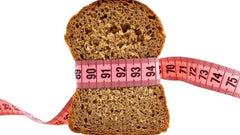
How Many Calories Should I Eat to Lose Weight?
Dieting can be confusing. Should you eat this? Should you avoid that? Many of us just want to know up front – how many calories should I eat to lose weight? Here’s a 3-step process to help you calculate exactly that.
Why count calories?
Reducing your daily calories can be a very effective way to lose weight, but it needs to be a calculated cut if you want to enjoy long-term success.
A calorie (cal) is a unit that measures the energy stored in food. Our body uses calories from food and beverages to fuel our essential life functions. Everything from blood circulation to kidney function and even physical activity relies on it.
We need a specific number of calories each day to maintain our bodily processes and activities. If you regularly consume more calories than your body needs, it converts them into stored energy. Basically, excess calories turn into body fat. If you eat fewer calories, however, your body can re-convert fat and use it as fuel – hence the term ‘fat burn’.
But simply cutting a random number of calories won’t always result in weight loss. If you cut too many you may stress the body with nutrient deprivation, and if you don’t cut enough, you’ll just maintain your current weight.
Understanding your specific caloric needs is a key part of successful and healthy weight loss.
Step 1: Calculate your basal metabolic rate
To start your calorie calculations for weight loss, you need to know your Basal Metabolic Rate (BMR). This is the base amount of calories needed to maintain your daily vital functions. We often forget our body is working hard outside of the gym in tasks we take for granted such as breathing, tissue repair and more.
Your BMR accounts for ⅔ of your total daily calories and is directly affected by your current body mass, hence a 200 lb person requires more energy to fuel their body’s system than someone who is 140lb.
Calculate your BMR
Simply enter your sex, age, weight, and height in the calculator below to generate your BMR. Keep this number handy for the next step.
Not eating enough calories
You could be sabotaging your weight loss efforts if you’re eating fewer calories than your BMR. Eating below your BMR puts your body into a starvation mode. Although this can result in weight loss in the beginning, it can also negatively impact your body in the long term. In response to the starvation stress, your body slows your digestion and energy conversion. As a result, your weight loss will begin to slow down.
Eating less or burning more calories will help you to manage your weight, but you need to calculate your total daily caloric expenditure before you start cutting calories.
Why a crash diet is not a good option to lose weight >>
Step 2: Calculate your total daily caloric expenditure

This is the number of calories you burn each day with exercise and normal activities. If you sit for long periods of time your total daily calorie expenditure (TDCE) will be less than someone who stands all day.

Step 3: Calculate your deficiency
Your next step is to calculate how many calories you’ll intentionally cut out each day. If you eat your TDCE calories, you’ll maintain your weight and if you eat more you’ll gain weight. Planning a small calorie deficiency allows your body to start ‘burning fat’.
Calories to lose weight formula
Use the following formula to work out how many calories you need to consume in order to lose weight:
TDCE – 500 = calories to lose weight each day
Caution
The goal is to eat less, but not to stress the body into starvation mode. This can be accomplished by ensuring that you don’t drop more than 500 calories below your TDCE. For example, if your TDCE is 2,000 calories per day, you should eat at least 1,500 calories per day.
Furthermore, women should not drop their daily calories below 1,200, nor men below 1,500. This type of excessive calorie restriction limits your nutrients and can deprive your body of the energy, vitamins, minerals, and elements it needs to thrive.
Reassess your TDCE
You’ll need to reassess how many calories you need to be consuming to lose weight both when you change your exercise routine and after you lose 10 lb – 20 lbs. The longer or harder your workout routine, the more calories you burn in your TDCE. The more weight you lose, the fewer calories you burn in your BMR.
Weight loss plateau
A weight loss plateau is a good reminder to recheck your TDCE and BMR. You’ll need to reduce your calories slowly as you lose weight. Remember not to drop below 1,200 calories per day for women and 1,500 calories for men.
Ketone check
Checking for ketones in your urine can also help you determine whether your calorie and exercise plan are still effective in helping you to burn fat. When the body converts fat into usable energy, it creates a byproduct called ‘ketone bodies’.
These are passed out of the body in urine and you can monitor them with a ketone urine strip. You can find these over the counter at most local drug stores.
The quality of your calories
The quality of your calories matters just as much as the quantity. It’ll be hard to lose weight if your total daily calories are being filled with high levels of sugar, refined grains, and saturated fat.
Eating a balance of whole grains, vegetables, fresh fruit, lean proteins, and legumes will provide great energy for your workouts and help you to feel full while you’re cutting calories.
Apps
You can make tracking your total daily calories and nutrients easier with apps like Myfitnesspal or Lose it.
Bottom line
Restricting your total daily calories can help you to lose weight. But you have to respect your body’s energy needs in order to lose weight in a healthy manner and keep it off.
Calculating your total daily calorie needs removes a lot of the guesswork and frustration from your weight loss efforts and helps keep you on track. Be sure to eat a balanced diet, reassess your calorie needs as you progress, and be mindful not to over-restrict yourself.
Check also: Compare Your Weight Loss Results to Objects to See Progress >>
What’s your favorite DIY low-calorie snack? We’d love to hear about it in the comments below!




